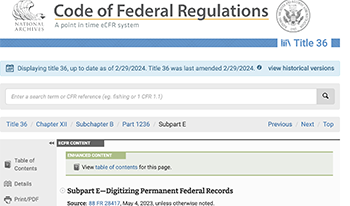
The United States National Archives and Records Administration (NARA) has issued new regulations that establish standards for the digitization of US government records. The regulations are part of an effort to transition to a fully electronic government, and allow US federal agencies the authority to digitize and destroy source records and the electronic version become the recordkeeping copy. The specifications draw upon established international digitization standards such as ISO 19264, Metamorfoze, and FADGI guidelines. By adopting the image quality specifications found in ISO 19264 and the image analysis method described by FADGI, NARA has effectively defined the minimum requirements for a digital surrogate to serve as legal and evidentiary purpose as the source record. This paper presents the records management context of digitization, as well as discussing the quality management, documentation, image and metadata specifications, and validation requirements.
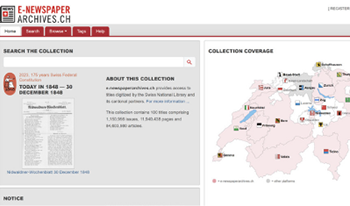
The Swiss National Library (SNL) operates a variety of different digitization projects for different kinds of materials. The biggest part of the pie contains newspapers. Newspapers are of high interest to the public and to researchers in the Digital Humanities field. The effort must be made to put as much as possible newspapers online. The SNL as per her strategy is to take a leading role in this digitization effort. This paper will describe how the newspapers are digitized, what the SNL’s role is and how the pipeline is structured from original to online presentation.
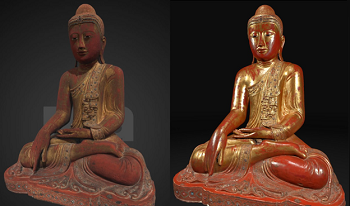
Advancements in accurate digitization of 3D objects through photogrammetry are ongoing in the cultural heritage space, for the purposes of digital archival and worldwide access. This paper outlines and documents several user-driven enhancements to the photogrammetry pipeline to improve the fidelity of digitizations. In particular, we introduce a new platform for capturing empirically-based specularity of 3D models called Kintsugi 3D, and visually compare traditional photogrammetry results with this new technique. Kintsugi 3D is a free and open-source package that features, among other things, the ability to generate a set of textures for a 3D model, including normal and specularity maps, based empirically on ground-truth observations from a flash-on-camera image set. It is hoped that the ongoing development of Kintsugi 3D will improve public access for institutions with an interest in sharing high-fidelity photogrammetry.
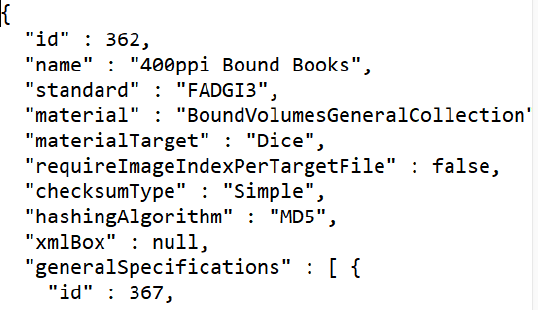
While we now have mature, proven guidelines (FADGI) which provide solid recommendations on how to create proper master files, beyond targets and the ability to measure them, the cultural heritage community lacks easily consumable, flexible specifications for conducting actual projects. Moreover, there is a general lack of examples of FADGI-compliant Statements of Work, leading to much re-invention of the wheel and even to library and archival personnel deciding to not use FADGI at all. This puts inexperienced users at a decided disadvantage and creates a formidable barrier to entry for new practitioners who want to use the FADGI guidelines on their projects. As discussed in this paper, a DIO (or Digitization Information Object) is a data model encompassing all technical parameters of a still image digitization project. At its core, the DIO schema is intrinsically tied to FADGI, and enforces FADGI compliance through its use. It provides a common, machine-readable instruction set for digitization-facing software programs. This allows consuming applications to be quickly and precisely configured per-project to specify output image parameters, configure post-processing workflows, verify both working files and huge batches of completed content at scale, and even to provide plain-English text for a project's Statement of Work -- all from the same DIO JSON file.
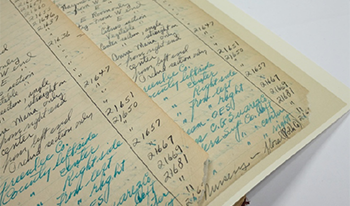
The goal of digitization is typically to create digital assets which represent the physical object as a means of digital preservation or access. On occasion, projects require bringing those digital images back into the physical world in the form of a facsimile. While reproducing objects for display and/or use is a common and well-established practice, there are unique cases that require innovative applications of existing tools and methods. Working closely with NEDCC’s book conservation lab, we imaged eight ledger books and then printed two copies of each to be rebound into near-identical, usable copies. Using this project as a case study, we will share some of the successes and hurdles we encountered while working through this large volume of material, with particular attention to deviations in image capture and processing workflows when producing bound facsimiles.
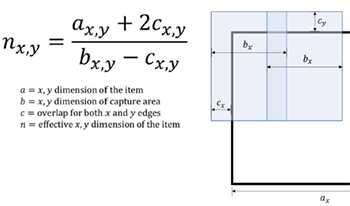
Over the last decade, medium format imaging solutions have made instantaneous capture of large 2D objects possible, dramatically increasing the throughput and image quality of digitization in cultural heritage applications. Despite this, the process of digitizing oversized objects, such as original artwork and scroll manuscripts is substantially more complicated; little research has been conducted on the efficacy of using such medium format solutions for this purpose. In this study, a workflow for digitizing a collection of oversized artwork according to the Federal Agencies Digital Guidelines Initiative (FADGI) guidelines was developed. Successful development of this process demonstrates the potential this process and others like it have to expand the applications of cultural heritage digitization solutions.

The Library of the Institute for the Study of the Ancient World (ISAW) at New York University aims to provide access to scholarship on the ancient world for the widest audience possible, both domestically and internationally, via our digital library collections. Our latest project, the Digital South Caucasus Collection (DSCC), is an international collaboration between ISAW and archaeological institutions in the south Caucasus that seeks to preserve and provide open access scholarship on the ancient south Caucasus. This poster describes some of the initial challenges and approaches to building a digital library project during a global pandemic. The project is very much a work in progress, but has already provided various insights into collaborating with international institutions on digital library collections.

Application of optical metrology techniques in the collection of surface data and its 3D representation can improve the digital documentation of the conservation and restoration process of artworks. The tracking of induced change after the restoration process on cultural heritage (CH) surfaces involves a computational analysis of surface geometry. In the analysis, the conservation scientists were interested to see what impact the fillings of some holes have on its nearby surrounding during the reconstruction. In theory, the loss compensation method for stone should allow conservators to make a filling that only exists in the place of the void, but it is highly unlikely to make a filling that will only adhere to the substrate at the void site and not protrude elsewhere. According to the conservator scientists, we proposed an approach of local geometry changes to identify and visualize changes and presented the outcome through a local neighborhood distance histogram. This analysis will give us overall surface change considering each surface point and its respective neighborhood points and what impact it faced due to the reconstruction process. The work is also focused on developing the representation of each type of loss compensation method to make it more objective according to a restorer’s point of view and simplify their work visibility.